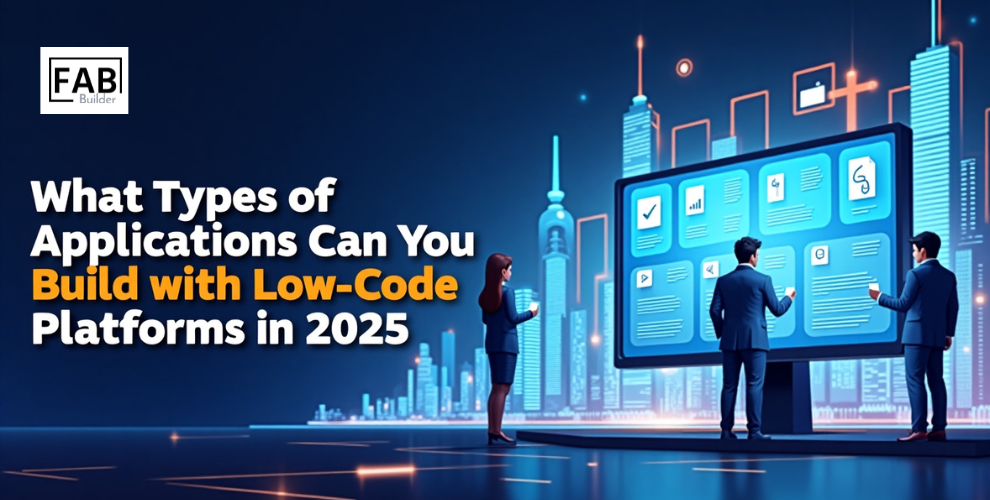What Types of Applications Can You Build with Low-Code Platforms in 2025?

The race for digital transformation has never been faster. Businesses and individuals are no longer willing to wait months — or even years — for applications to be built the traditional way. Instead, they are searching for smarter, faster, and more efficient solutions to turn ideas into reality.
Enter low-code platforms in 2025 — a game-changer in modern application development. Fueled by AI code generators and next-generation application development platforms, low-code empowers both developers and non-developers to create powerful, scalable, and feature-rich applications without writing endless lines of code.
This year, low-code is no longer just a supporting tool — it’s becoming the driving force of software creation, enabling businesses to innovate at scale, reduce costs, and accelerate time-to-market like never before.
In this article, we’ll uncover the types of applications you can build with low-code platforms in 2025, explore how cutting-edge tools like FAB Studio are transforming industries, and explain why low-code has evolved from being an “alternative” into the mainstream choice for modern application development.
What is a Low-Code Platform in 2025?
A low-code platform is a development environment that allows users to design, build, and deploy applications using minimal hand-coding. By 2025, these platforms have evolved into intelligent systems powered by AI code generators and automated code builders, making them more efficient than ever before.
Unlike traditional development, where applications require months or even years to create, low-code development accelerates delivery timelines, reduces costs, and empowers organizations to remain competitive. Whether for enterprise-scale solutions or niche internal tools, low-code platforms provide a versatile foundation for application development.
How Are Low-Code Platforms Reshaping Application Development in 2025?
The shift to low-code platforms represents a significant change in the way businesses approach application development. Instead of manually writing thousands of lines of code, these platforms use code builders and visual drag-and-drop interfaces to streamline the process.
By integrating AI-powered code generation, platforms like FAB Studio act as both a low-code platform and a code generator, automating repetitive tasks while ensuring application performance and security remain intact.
In 2025, these advancements are no longer limited to prototypes or simple applications. Businesses across industries are leveraging low-code application development platforms to create complex, enterprise-grade applications that were once thought to be impossible without a large team of developers.
What Types of Applications Can You Build with Low-Code Platforms?
The versatility of low-code platforms has expanded dramatically. Let’s dive into the categories of applications that businesses can create in 2025.
Can You Build Enterprise Applications with Low-Code Platforms?
One of the most common questions businesses ask is whether low-code platforms in 2025 can support large-scale enterprise applications. The answer is a resounding yes.
With modern low-code application development platforms, organizations can now build enterprise-grade solutions such as:
-
Customer Relationship Management (CRM) Systems — Tailored solutions to streamline client communication, sales pipelines, and customer service operations.
-
Enterprise Resource Planning (ERP) Applications — Comprehensive tools for managing supply chains, finance, HR, and other business operations.
-
Workflow Automation Platforms — Applications designed to automate complex workflows, saving time and reducing errors.
These enterprise applications benefit from the scalability of AI-driven code generation platforms, making them adaptable as businesses grow.
Can You Build E-Commerce and Retail Applications with Low-Code?
In 2025, e-commerce is one of the fastest-growing industries, and low-code platforms are playing a vital role in its expansion. Low-code platforms enable the creation of:
-
E-commerce Websites and Mobile Apps — Fully functional online stores with payment gateways, inventory management, and personalized shopping experiences.
-
Retail Management Systems — Tools that manage stock, process sales, and integrate loyalty programs.
-
Customer-Centric Mobile Apps — Personalized apps for customers to track orders, receive offers, and engage with brands.
Thanks to AI code generators, even complex integrations like chatbots, product recommendations, and real-time analytics can be incorporated without advanced coding knowledge.
Are Low-Code Platforms Suitable for Healthcare Applications?
Healthcare requires high levels of security, compliance, and real-time functionality. With low-code development in 2025, providers are creating:
-
Patient Portals — Secure platforms for booking appointments, accessing medical records, and communicating with doctors.
-
Telehealth Applications — Virtual consultation apps with prescription management and patient monitoring.
-
Hospital Management Systems — Tools to manage staff scheduling, admissions, and billing.
Using FAB Studio’s low-code platform, healthcare apps are built with compliance in mind, ensuring adherence to regulations like HIPAA and GDPR.
Can You Build Financial and Banking Applications with Low-Code?
The financial industry demands efficiency, security, and compliance. In 2025, low-code application platforms support:
-
Digital Banking Apps — Full-featured apps with account management, fund transfers, and transaction tracking.
-
FinTech Platforms — Investment tracking tools, digital wallets, and personal finance apps.
-
Fraud Detection Systems — AI-enhanced apps to detect and prevent suspicious activities.
By using code generation platforms, banks and FinTech startups can innovate faster without compromising on compliance.
Can Low-Code Platforms Build Educational Applications?
The education sector has rapidly transformed, and low-code platforms in 2025 are central to this shift. Institutions can create:
-
Learning Management Systems (LMS) — Online courses, assessments, and certification platforms.
-
Student Portals — Apps for progress tracking, assignments, and communication.
-
Virtual Classrooms — Systems with live video, chat, and collaboration tools.
With the help of AI-powered code generators, apps can personalize learning paths and adjust to individual student performance.
Can You Build Customer-Facing Mobile Applications with Low-Code?
Yes. Mobile apps remain among the most in-demand solutions built with low-code development platforms. Businesses are building:
-
On-Demand Service Apps — From food delivery to ride-hailing.
-
Booking and Reservation Apps — Travel, hospitality, and event apps with secure payments.
-
Social Networking Apps — Niche community platforms.
With FAB Studio’s AI-driven code builder, developers can automate repetitive tasks, ensuring faster delivery and high quality.
Can Low-Code Platforms Be Used for Government and Public Sector Applications?
Governments worldwide are adopting low-code platforms for efficiency and citizen engagement. In 2025, public sector applications include:
-
Citizen Service Portals — For accessing services, applying for documents, and making payments.
-
Data Management Systems — Secure tools to manage sensitive information.
-
Smart City Applications — Real-time monitoring for traffic, utilities, and emergency services.
Low-code platforms help governments implement applications faster while staying compliant with regulatory frameworks.
Can You Build AI-Driven Applications with Low-Code?
One of the most exciting advancements in 2025 is the integration of AI in low-code platforms. Developers can now create AI-powered applications such as:
-
Chatbots and Virtual Assistants — AI-driven customer support.
-
Predictive Analytics Tools — Applications that analyze data trends and forecast outcomes.
-
Image and Voice Recognition Apps — Healthcare, retail, and security applications.
Using a modern AI code generator, these apps are built with less effort and greater speed.
Can Low-Code Platforms Build Industry-Specific Applications?
Yes. A major strength of low-code platforms in 2025 is their flexibility across industries. Examples include:
-
Logistics & Supply Chain Tools — Real-time tracking, fleet management, predictive logistics.
-
Manufacturing Applications — Production scheduling, equipment monitoring, and inventory control.
-
Hospitality Platforms — Reservation systems, guest experience apps, and hotel management tools.
The adaptability of application development platforms ensures tailored solutions for any sector.
How Can FAB Studio Help You Build Applications Faster with a Low-Code Platform?
FAB Studio is the generative AI-powered low-code, application development arm of FAB Builder’s integrated platform. According to the official FAB Builder website, FAB Studio enables users to “develop web & mobile apps” using AI assistance, with “hundreds of pre-built templates” and “full access to source code.”
Here’s how FAB Studio makes low-code application development faster:
-
Templates at your fingertips — Start with ready-made dashboards, CRMs, and onboarding flows.
-
AI-driven generation — Describe your app, and the platform generates frontend, backend, and database components.
-
Visual refinement — Customize layouts, logic, workflows, and navigation.
-
Source code access — Retain full control, auditability, and migration options.
-
Real-time deployment — Preview and deploy instantly.
-
Integrated analytics & engagement — Leverage FAB Builder’s ecosystem for customer insights and personalization.
With FAB Studio, you’re not just building apps — you’re building intelligent, connected applications ready for future growth.
Final Thoughts: Why Low-Code Platforms Are the Future of Application Development
The evolution of low-code platforms in 2025 shows us that they are no longer just an alternative but a necessity. From enterprise applications and e-commerce platforms to healthcare, education, and AI-driven tools, low-code enables rapid innovation without compromising on security or scalability.
Platforms like FAB Studio are leading this revolution by combining the power of an AI code generator, code builder, and application development platform into a single, unified solution.
As industries continue to embrace digital-first strategies, the importance of low-code application development will only grow stronger — making it one of the most critical drivers of digital transformation in 2025 and beyond.
FAQ
1. What types of applications can be built with low-code platforms in 2025?
You can build enterprise apps, e-commerce platforms, healthcare systems, financial apps, mobile apps, and AI-driven solutions.
2. Are low-code platforms suitable for enterprise-grade applications?
Yes, modern low-code platforms support CRM, ERP, and workflow automation at enterprise scale.
3. Can low-code platforms handle secure industries like healthcare and banking?
Absolutely. Low-code platforms in 2025 ensure compliance with regulations such as HIPAA and GDPR while maintaining strong security.
4. How does FAB Studio support low-code application development?
FAB Studio combines AI-driven code generation, pre-built templates, and source code access to help businesses build apps faster.
5. Why are low-code platforms important for businesses in 2025?
They reduce development time and cost while enabling innovation, scalability, and digital transformation across industries.
- Art
- Causes
- Best Offers
- Crafts
- Dance
- Drinks
- Film
- Fitness
- Food
- Spellen
- Festival
- Gardening
- Health
- Home
- Literature
- Music
- Networking
- Other
- Party
- Religion
- Shopping
- Sports
- Theater
- Wellness



